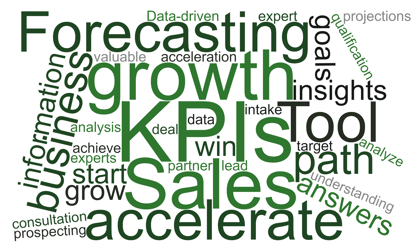How much money is your startup going to bring in? It’s a question that every founder needs to answer because cash flow is the lifeblood of every company. It is imperative to use key performance indicators (KPIs) to closely measure the progress and performance of a startup or scaleup.
The Management Study Guide defines KPIs as, “a measurement that tells management the precise state of operations at any given point of time.”
Another way to look at KPIs may be to think of the cockpit of an airplane and the dozens of gauges tracking data points like altitude, direction, and cabin pressure so pilots have better information to fly the plane. Sales KPIs are much the same for businesses, tracking important data points such as the number of leads engaged, current deal pipeline, and number of deals closed so business leaders have better information to make better decisions and run the company.
Rather than relying on gut-level instinct and a top line or bottom line number, sales KPIs provide an in-depth look at measurable indicators to get a better picture of how elements within the business are performing and where there may be opportunities to improve. Sales KPIs can also be used to identify trends and predict future performance. Organizations use tools to not only track past performance, but to help forecast growth based on the right mix of KPIs for that business.
Complete your Growth Acceleration Starting Grid here.
There’s no perfect formula or rule book for how many KPIs to track, though many analysts say for practical purposes a founding team should focus on five to seven indicators to monitor. It’s easy to get tangled up in data if you track too many KPIs, and that can cause a company to lose focus of what it needs to accomplish on a daily, weekly or monthly basis to continue to build value.
It’s also important to track sales KPI data over time horizons that provide proper context, optimizing time spent by the company’s leaders. There may be little value in doing a daily check of B2B sales KPIs for a product with a long sales cycle. Instead, a weekly look at select sales KPIs may be a better starting point. Like watching your stock portfolio every hour of every trading day, watching sales KPIs over the wrong time horizon may lead to unnecessary over-corrections based on information that is not providing a relevant picture of how the company is performing. The right sales KPI timeline and context for your business should provide you with insights that can be actionable to increase your profits, shorten your sales cycles and improve your deal outcomes.
Companies use KPIs to monitor their overall health and tell their story to potential investors and other key stakeholders. Important information including market share opportunity, revenue per average customer, length of the sales cycle, number of current customers, and number of current leads are great starting points for conversations about company growth. Commonly used sales KPIs include number of new target prospects, funnel stage, revenue pipeline, new customer wins and losses, and other custom reports (such as time in stage, sales cycle time based on sector) based on a specific business at a specific point in time. Demand generation, for example, might track funnel benchmarks (including visitors, leads, MQLs and SQLs), cost per lead, and email opens and clickthrough rates. Monitoring and understanding KPIs can help organizations stay on track to achieve their goals.
Many B2B startups, especially those in the technology space, have founders with data-rich backgrounds. They can get lost in their element, sifting through loads and sets of information, turning KPIs into something of a plaything, or at least a thing to constantly tinker with and look at from every direction possible. If KPIs create a “can’t tell the forest from the trees” situation, it can be easy to lose perspective on what is really driving a company’s success.
The right mix of sales KPIs can deliver intelligence about what parts of the sales cycle are working well and what could benefit from adjustments, whether fine tuning or a complete overhaul, in order to improve growth performance. Sales are based on iterative improvement, and understanding the data around how many contacts and activities are being converted into opportunities and then deals is an essential component of operating a growing business.
Gone are the days of epic sales heroes who could “sell ice to an Eskimo” based on charm and charisma alone. Instead, data is the fuel for the modern sales engine. Tracking sales KPIs takes some discipline but can provide invaluable insights into optimizing your business. Whether using simple spreadsheets or enterprise-level data platforms, a great way to use KPIs in a startup is to find one or two “north star” metrics that clearly spell out if the company is growing and finding success. Focusing on a few KPIs will help align your business operations around what really matters.
As your business evolves and you find more value in your existing KPIs, you can add new ones to increase visibility into performance. Add dashboards and automation for real-time access and drill-down capabilities for a deeper dive into performance information. Remember to not obsess over the numbers or let them get in the way of the other vital activities of growing and running the business. Instead, use sales KPIs for insight, transparency and the opportunity to focus on optimizing your organization.
Because measurement and improved performance are crucial to the success of companies of all sizes, leaders need to have the best data available when it comes time to make business decisions. Sales KPIs can provide a reliable forecast for company growth, cash flow and the answer to that all-important question for startup founders, “How much money is your startup going to bring in?”
Learn more about the most important sales KPIs for a tech startup.